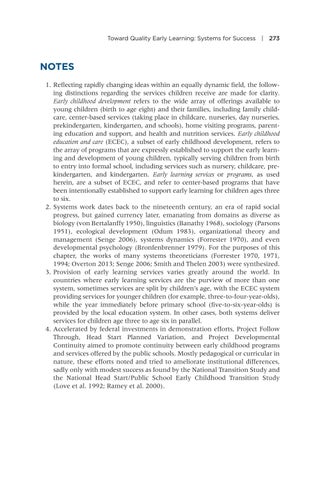Toward Quality Early Learning: Systems for Success | 273
NOTES 1. Reflecting rapidly changing ideas within an equally dynamic field, the following distinctions regarding the services children receive are made for clarity. Early childhood development refers to the wide array of offerings available to young children (birth to age eight) and their families, including family childcare, center-based services (taking place in childcare, nurseries, day nurseries, prekindergarten, kindergarten, and schools), home visiting programs, parenting education and support, and health and nutrition services. Early childhood education and care (ECEC), a subset of early childhood development, refers to the array of programs that are expressly established to support the early learning and development of young children, typically serving children from birth to entry into formal school, including services such as nursery, childcare, prekindergarten, and kindergarten. Early learning services or programs, as used herein, are a subset of ECEC, and refer to center-based programs that have been intentionally established to support early learning for children ages three to six. 2. Systems work dates back to the nineteenth century, an era of rapid social progress, but gained currency later, emanating from domains as diverse as biology (von Bertalanffy 1950), linguistics (Banathy 1968), sociology (Parsons 1951), ecological development (Odum 1983), organizational theory and management (Senge 2006), systems dynamics (Forrester 1970), and even developmental psychology (Bronfenbrenner 1979). For the purposes of this chapter, the works of many systems theoreticians (Forrester 1970, 1971, 1994; Overton 2013; Senge 2006; Smith and Thelen 2003) were synthesized. 3. Provision of early learning services varies greatly around the world. In countries where early learning services are the purview of more than one system, sometimes services are split by children’s age, with the ECEC system providing services for younger children (for example, three-to-four-year-olds), while the year immediately before primary school (five-to-six-year-olds) is provided by the local education system. In other cases, both systems deliver services for children age three to age six in parallel. 4. Accelerated by federal investments in demonstration efforts, Project Follow Through, Head Start Planned Variation, and Project Developmental Continuity aimed to promote continuity between early childhood programs and services offered by the public schools. Mostly pedagogical or curricular in nature, these efforts noted and tried to ameliorate institutional differences, sadly only with modest success as found by the National Transition Study and the National Head Start/Public School Early Childhood Transition Study (Love et al. 1992; Ramey et al. 2000).




